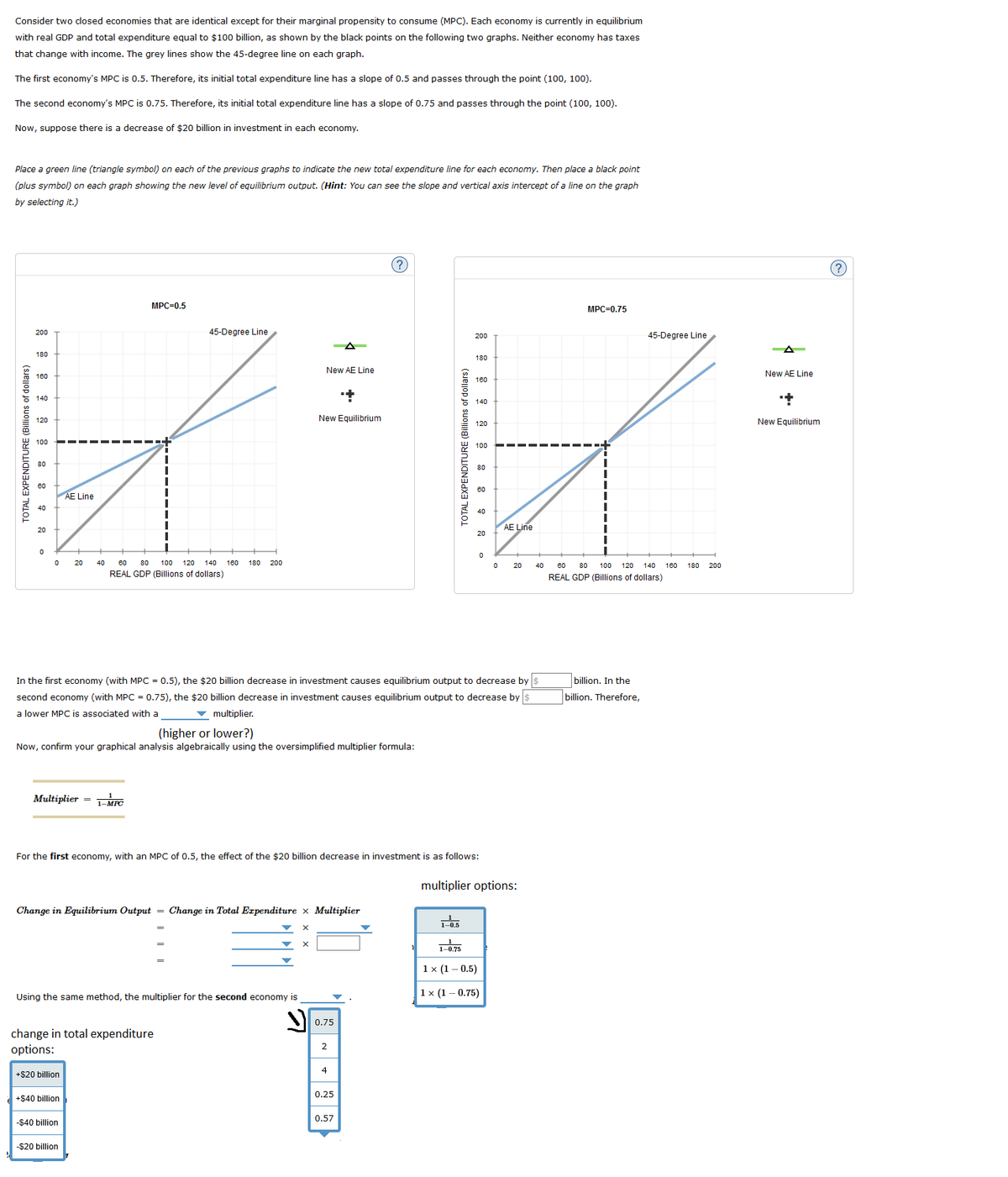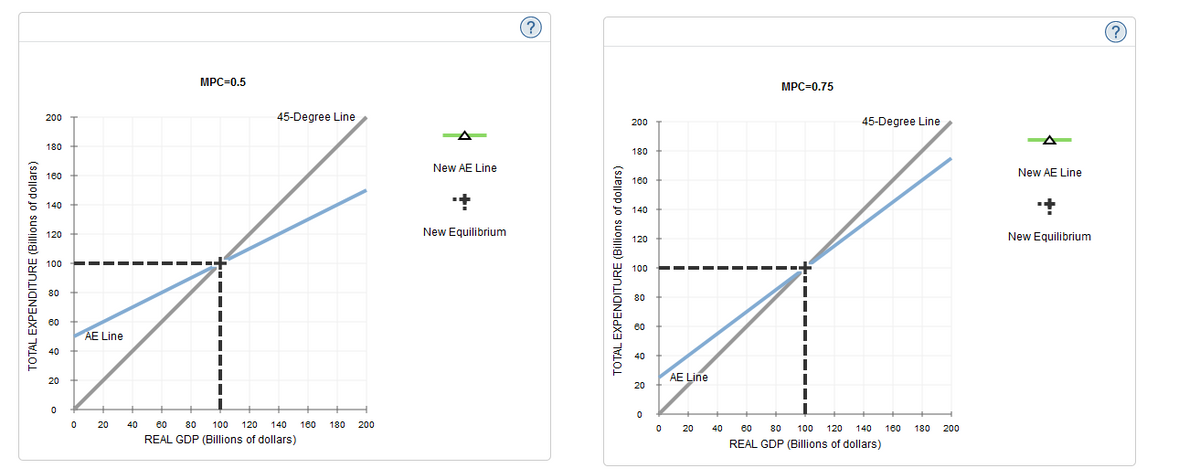Consider two closed economies that are identical except for their marginal propensity to consume (MPC). Each economy is currently in equilibrium with real GDP and total expenditure equal to $100 billion, as shown by the black points on the following two graphs. Neither economy has taxes that change with income. The grey lines show the 45-degree line on each graph. The first economy's MPC is 0.5. Therefore, its initial total expenditure line has a slope of 0.5 and passes through the point (100, 100). The second economy's MPC is 0.75. Therefore, its initial total expenditure line has a slope of 0.75 and passes through the point (100, 100). Now, suppose there is a decrease of $20 billion in investment in each economy. Place a green line (triangle symbol) on each of the previous graphs to indicate the new total expenditure line for each economy. Then place a black point (plus symbol) on each graph showing the new level of equilibrium output. (Hint: You can see the slope and vertical axis intercept of a line on the graph by selecting it.) MPC=0.5 MPC-0.75 200 45-Degree Line 45-Degree Line 200 A 180 180 New AE Line 160 New AE Line 100 140 E 140 120 New Equilibrium New Equilibrium 120 出 100 100 80 80 60 60 AE Line 40 40 AE Line 20 20 20 40 60 80 100 120 140 180 180 200 20 40 60 80 100 120 140 180 180 200 REAL GDP (Billions of dollars) REAL GDP (Billions of dollars)
Consider two closed economies that are identical except for their marginal propensity to consume (MPC). Each economy is currently in equilibrium with real GDP and total expenditure equal to $100 billion, as shown by the black points on the following two graphs. Neither economy has taxes that change with income. The grey lines show the 45-degree line on each graph. The first economy's MPC is 0.5. Therefore, its initial total expenditure line has a slope of 0.5 and passes through the point (100, 100). The second economy's MPC is 0.75. Therefore, its initial total expenditure line has a slope of 0.75 and passes through the point (100, 100). Now, suppose there is a decrease of $20 billion in investment in each economy. Place a green line (triangle symbol) on each of the previous graphs to indicate the new total expenditure line for each economy. Then place a black point (plus symbol) on each graph showing the new level of equilibrium output. (Hint: You can see the slope and vertical axis intercept of a line on the graph by selecting it.) MPC=0.5 MPC-0.75 200 45-Degree Line 45-Degree Line 200 A 180 180 New AE Line 160 New AE Line 100 140 E 140 120 New Equilibrium New Equilibrium 120 出 100 100 80 80 60 60 AE Line 40 40 AE Line 20 20 20 40 60 80 100 120 140 180 180 200 20 40 60 80 100 120 140 180 180 200 REAL GDP (Billions of dollars) REAL GDP (Billions of dollars)
Chapter9: The Keynesian Model In Action
Section: Chapter Questions
Problem 18SQ
Related questions
Question
Right click on image and click on open image in new tab to see the full and clear image.
Consider two closed economies that are identical except for their marginal propensity to consume (MPC). Each economy is currently in equilibrium with real GDP and total expenditure equal to $100 billion, as shown by the black points on the following two graphs. Neither economy has taxes that change with income. The grey lines show the 45-degree line on each graph.
The first economy's MPC is 0.5. Therefore, its initial total expenditure line has a slope of 0.5 and passes through the point (100, 100).
The second economy's MPC is 0.75. Therefore, its initial total expenditure line has a slope of 0.75 and passes through the point (100, 100).
Now, suppose there is a decrease of $20 billion in investment in each economy.
Place a green line (triangle symbol) on each of the previous graphs to indicate the new total expenditure line for each economy. Then place a black point (plus symbol) on each graph showing the new level of equilibrium output. (Hint: You can see the slope and vertical axis intercept of a line on the graph by selecting it.)

Transcribed Image Text:Consider two closed economies that are identical except for their marginal propensity to consume (MPC). Each economy is currently in equilibrium
with real GDP and total expenditure equal to $100 billion, as shown by the black points on the following two graphs. Neither economy has taxes
that change with income. The grey lines show the 45-degree line on each graph.
The first economy's MPC is 0.5. Therefore, its initial total expenditure line has a slope of 0.5 and passes through the point (100, 100).
The second economy's MPC is 0.75. Therefore, its initial total expenditure line has a slope of 0.75 and passes through the point (100, 100).
Now, suppose there is a decrease of $20 billion in investment in each economy.
Place a green line (triangle symbol) on each of the previous graphs to indicate the new total expenditure line for each economy. Then place a black point
(plus symbol) on each graph showing the new level of equilibrium output. (Hint: You can see the slope and vertical axis intercept of a line on the graph
by selecting it.)
(?
(?)
МРC-0.5
МРC-0.75
200
45-Degree Line
45-Degree Line
200
180
180
New AE Line
New AE Line
160
160
E 140
140
120
New Equilibrium
New Equilibrium
120
100
100
80
60
AE Line
40
AE Line
20
20
20
40
60
80
100
120
140 180
180
200
20
40
60
80
100
120
140
180
180
200
REAL GDP (Billions of dollars)
REAL GDP (Billions of dollars)
In the first economy (with MPC = 0.5), the $20 billion decrease in investment causes equilibrium output to decrease by $
billion. In the
second economy (with MPC = 0.75), the $20 billion decrease in investment causes equilibrium output to decrease by $
billion. Therefore,
a lower MPC is associated with a
multiplier.
(higher or lower?)
Now, confirm your graphical analysis algebraically using the oversimplified multiplier formula:
Multiplier =
1-MBG
For the first economy, with an MPC of 0.5, the effect of the $20 billion decrease in investment is as follows:
multiplier options:
Change in Equilibrium Output = Change in Total Expenditure x Multiplier
1 x (1– 0.5)
Using the same method, the multiplier for the second economy is
1x (1– 0.75)
0.75
change in total expenditure
options:
2
4
+$20 billion
0.25
+$40 billion
0.57
-$40 billion
-$20 billion
TOTAL EXPENDITURE (Billions of dollars)
TOTAL EXPENDITURE (Billions of dollars)

Transcribed Image Text:?
MPC=0.5
MPC=0.75
200
45-Degree Line
45-Degree Line
200
180
180
New AE Line
New AE Line
160
160
140
140
120
New Equilibrium
New Equilibrium
120
100
100
80
80
60
60
AE Line
40
40
AE Line
20
20
60
REAL GDP (Billions of dollars)
20
40
80
100
120
140
160
180
200
20
40
60
80
100 120 140 180 180
200
REAL GDP (Billions of dollars)
TOTAL EXPENDITURE (Billions of dollars)
TOTAL EXPENDITURE (Billions of dollars)
Expert Solution
This question has been solved!
Explore an expertly crafted, step-by-step solution for a thorough understanding of key concepts.
This is a popular solution!
Trending now
This is a popular solution!
Step by step
Solved in 3 steps with 2 images

Knowledge Booster
Learn more about
Need a deep-dive on the concept behind this application? Look no further. Learn more about this topic, economics and related others by exploring similar questions and additional content below.Recommended textbooks for you







